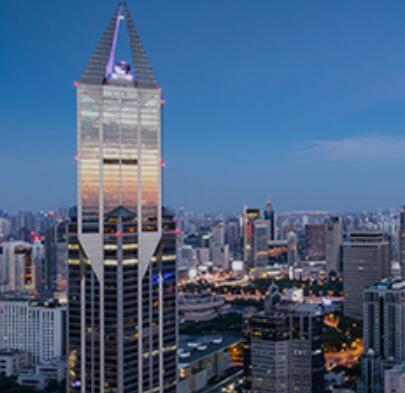1. Economic Strength
In 2017, the gross income of the tax revenue reached RMB 68.559 billion, a year-on-year growth of 5.77%; the general public budget revenue was RMB 23.28 billion, a year-on-year growth of 8.48%, ranking the top among central urban areas in terms of absolute value and growing rate; the total retail sales of consumer goods realized RMB 72.3 billion, a year-on-year growth of 16%; the total fixed asset investment reached RMB 31 billion.
2. Industrial Characteristics
Jing’an is the seat of West Nanjing Road and Shibei Hi-tech Park, which respectively is one of the most prosperous central business districts in Shanghai and a successful case of transition among downtown areas in the city. Like West Nanjing Road, Daning is also a municipal business zone, together with district-level commercial centers Caojiadu and Suhewan. In terms of economy, there are complete industrial chains, obvious south-north differentiation, diverse forms of business, and a whole range of industries. The headquarters economy, the commercial real estate economy and the export-oriented economy are all in full swing. Jing’an is a hotspot of high-end commercial real estates including Kerry Center, Wheelock Square, Plaza 66, Westgate Mall, CITIC Square, InterContinental Shanghai Puxi, Joy City and Kerry Everbright City. In 2017, commercial real estate accounted for 59.46% of the district’s total tax revenue; in particular, 67 buildings each paid taxes of more than RMB 100 million annually and 8 buildings even paid taxes of more than RMB 100 million monthly in average. The booming of Jing’an in commercial real estate has attracted a large batch of transnational corporations, regional headquarters and international enterprises. At present, 70 companies involving transnational corporations and regional headquarters have been settled in Jing’an. Maintaining a sound development momentum on foreign-related business, Jing’an District has attracted the foreign direct investment with contract value of USD 1.018 billion; the foreign-related business has witnessed a gross income of tax revenue of RMB 34.976 billion, accounting for 51.02% of that of the whole district.
3. Modern Service Industry
Trade service brands
There are many trade service brands in Jing’an. West Nanjing Road is economically influential over its neighboring streets including the famous leisure and entertainment street at Wujiang Road which was awarded “China Characteristic Business Street” in 2012. With a cluster of time-honored or self-owned brands, North Shaanxi Road was titled “China Time-honored Brand, Shanghai No. 1 Street” in 2009 by the Time-honored Brand Committee of China General Chamber of Commerce. Plaza 66, Kerry Center, Westgate Mall, CITIC Square, Jiuguang Department Store and Réel Department Store have become representative architectures of high-end commerce. In 2017, the trade service industry contributed taxes of RMB 17.584 billion.
Cluster of professional service headquarters
The professional service industry is of great importance for Jing’an to integrate with Shanghai’s strategic positioning as a city of “four centers.” Under open and efficient market circumstances, Jing’an has aggregated a considerable number of domestic and international enterprises professional in legal services, accounting audit, business consulting, investment management, human resources, and testing and certification. So far, many remarkable industrial parks have been established such as Shanghai Human Resources Service Industry Park and the country’s first National Public Inspection and Testing Service Platform Demonstration Area. In 2017, the professional service industry contributed taxes of RMB 13.449 billion.
Innovation and expansion of the financial service industry
Jing’an is home to scores of securities companies and divisions, as well as investment companies such as JPMorgan Chase and Morgan Stanley. To restructure the financial industry and explore the development of new finance, Jing’an has introduced a batch of innovative financial institutions like Christie’s, Haitong-Fortis, OCBC Capital, and Citadel Overseas Investment (one of the first QDLP enterprises in Shanghai). Companies like SAIC Finance and Shanghai Electric Group Finance also have contributed to the integrative development of the industry. In 2017, 8 key financial institutions were introduced, and the financial service industry contributed a tax revenue of RMB 8.8 billion.
Improved influence of cultural and creative industries
As a highland of the city’s cultural and creative industries featuring in the post production of film and television, the International Film and Television Industry Park at the Rim of Shanghai University is set to become a hotspot and a drive of the cultural prosperity and development of the city. With Changping Road as the main axis, the belt area of the cultural and creative industries in Jing’an has demonstrated a preliminary cluster effect in the consumption, R&D, exhibition and launch of domestic and international fashion brands. Focusing on Shanghai Media and Entertainment Group and Shanghai United Media Group, the culture and media street at Weihai Road constantly attracts the settlement of multinational media and advertising companies. With Nanjing Road and Huashan Road as the central axis, the Modern Drama Valley has become a famous cluster area of modern drama in the country. In 2017, cultural and creative industries contributed taxes of RMB 4.052 billion.
Growth of the information technology industry
Relying on policies and carriers including Shanghai’s cloud computing industry base, big data base, national digital media base, and homemade basic software base, Jing’an has aggregated a batch of leading enterprises and facilitated the cluster development of big data, cloud computing and urban rail transit signal industries. In 2017, Shanghai Big Data Alliance, Jing’an Service Center was in official operation; the Innovation Research Institute of Big Data Application was founded; 35 big data enterprises and 76 enterprises involved in other information technologies were introduced; the information technology service industry contributed taxes of RMB 4.417 billion in total.




 A single purchase
A single purchase









